 My colleague Sam Millette, senior investment research analyst on Commonwealth’s Investment Management and Research team, has helped me put together this month’s Market Risk Update. Thanks for the assist, Sam!
My colleague Sam Millette, senior investment research analyst on Commonwealth’s Investment Management and Research team, has helped me put together this month’s Market Risk Update. Thanks for the assist, Sam!
Equity markets rallied in June, which capped off a positive month and quarter for stocks. The S&P 500 gained 2.33 percent during the month while the Nasdaq Composite increased by 5.55 percent. Both indices set record highs before experiencing some late-month volatility. The Dow Jones Industrial Average lagged the S&P 500 and Nasdaq Composite due to poor results from a few constituents, but the index managed to return 0.02 percent in June.
Recession Risk
Recessions are strongly associated with market drawdowns. In fact, 8 of 10 bear markets have occurred during recessions. The National Bureau of Economic Research declared that a recession started last February. On top of that, despite the increased pace of hiring in June, total employment remains well below pre-pandemic levels, as we discussed in this month’s Economic Risk Factor Update.
With that being said, on the whole, the economic recovery continued to pick up steam in June. Given the improvements we saw during the month, we have kept the economic risk level at a yellow light for now, with an upgrade to green possible in the upcoming months, especially if we see the pace of hiring accelerate.
Economic Shock Risk
One major systemic factor is the price of money, otherwise known as interest rates. This drives the economy and financial markets and has historically had the ability to derail them. Rates have been causal factors in previous bear markets and deserve close attention.
Risk factor #1: The yield curve (10-year minus 3-month Treasury rates). We cover interest rates in the economic update, but they warrant a look here as well.
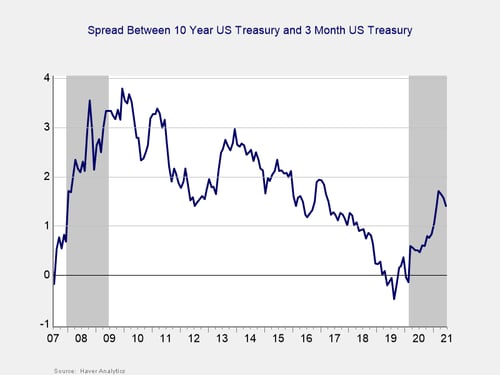
The yield curve flattened during the month, marking three consecutive months of yield curve flattening. This result was primarily driven by a decline in long-term interest rates. The 10-year Treasury yield fell from 1.58 percent at the end of May to 1.45 percent at the end of June. The decline in long-term yields was largely driven by investor concerns about the rising risk from the Delta variant of the virus. The 3-month Treasury yield increased from 0.01 percent at the end of May to 0.05 percent at the end of June. While short-term rates are expected to remain low until at least 2023, longer-term rates had previously recovered back to pre-pandemic levels before the recent decline.
Although long-term rates remain well above the pandemic-induced lows we saw throughout much of last year, the recent decline is worth monitoring, as it could signal investor concern about the pace of the economic recovery.
Given the fact that long-term yields remain above the 2020 lows, we have kept this signal at green light for now. If long-term rates continue to decline, however, we may see further yield curve flattening and a potential downgrade to yellow.
Signal: Green light
Market Risk
Beyond the economy, we can also learn quite a bit by examining the market itself. For our purposes, two things are important:
- To recognize what factors signal high risk
- To try to determine when those factors signal that risk has become an immediate, rather than theoretical, concern
Risk factor #1: Valuation levels. When it comes to assessing valuations, we find longer-term metrics—particularly the cyclically adjusted Shiller P/E or price to earnings ratio, which looks at average earnings over the past 10 years—to be the most useful in determining overall risk.
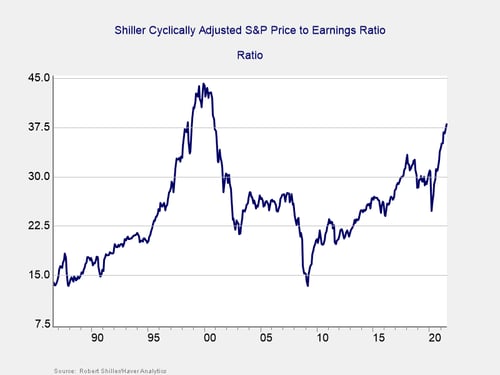
Valuations continued to rise in July, as the CAPE Shiller ratio rose from 37.05 in June to 37.98 in July. This marks four consecutive months with rising equity market valuations, and it left the Shiller CAPE ratio at its highest level since late 2000.
Even as the Shiller P/E ratio is a good risk indicator, it is a terrible timing indicator. To get a better sense of immediate risk, we can turn to the 10-month change in valuations. Looking at changes, rather than absolute levels, gives a sense of the immediate risk level, as turning points often coincide with changes in market trends.
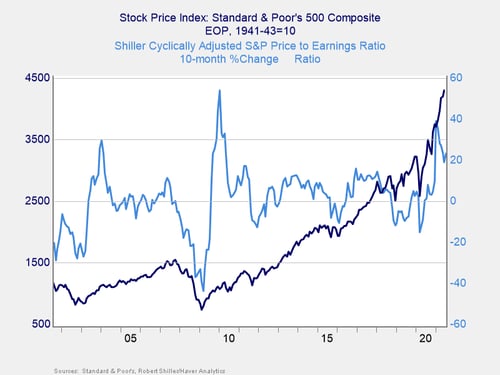
Here, you can see that when valuations roll over, with the change dropping below zero over a 10-month or 200-day period, the market itself typically drops shortly thereafter. This relationship held last March, as valuations and the index both rolled over before rebounding. On a 10-month basis, valuations rose by 23.1 percent in July, up from the 18.9 percent increase that we saw in June. Given the historically high valuation levels, we have kept this indicator as a yellow light for now, despite the fact that valuation changes have remained outside of the danger zone since May 2020.
Signal: Yellow light
Risk factor #2: Margin debt. Another indicator of potential trouble is margin debt.
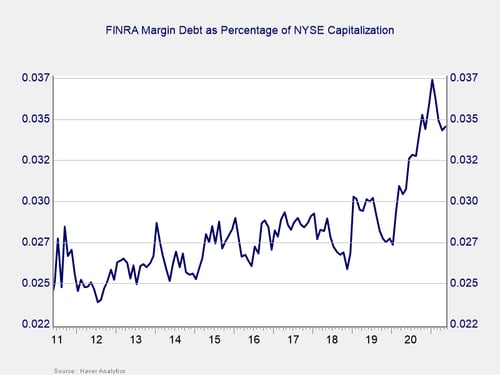
Debt levels as a percentage of market capitalization increased notably with the onset of the pandemic, hitting a new high in January 2021. Since then, we’ve seen margin debt as a percentage of market capitalization decline. Margin debt increased modestly in May, however, breaking a three-month streak of declines. The high level of debt associated with the market is a risk factor on its own but not necessarily an immediate one.
For immediate risk, changes in margin debt over a longer period are a better indicator than the level of that debt. Consistent with this, if we look at the change over time, spikes in debt levels typically precede a drawdown.
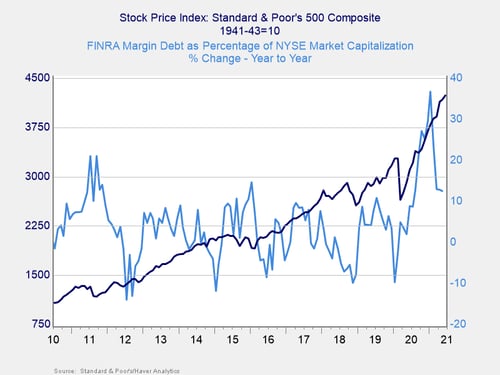
As you can see in the chart above, the year-over-year growth in margin debt as a percentage of market capitalization declined in May to 12.46 percent. This is the lowest level of year-over-year margin debt growth since last July and is well below the recent high of 36.76 percent we saw in January.
Given the fact that margin debt remains below January’s high and that the pace of year-over-year growth continued to slow, we have left this signal at yellow for now. With that being said, the still high level of margin debt on a historical basis is a risk that should be monitored.
Signal: Yellow light
Risk factor #3: Technical factors. A good way to track overall market trends is to review the current level versus recent performance. Two metrics we follow are the 200-day and 400-day moving averages. We start to pay attention when a market breaks through its 200-day average, and a break through the 400-day often signals further trouble ahead.
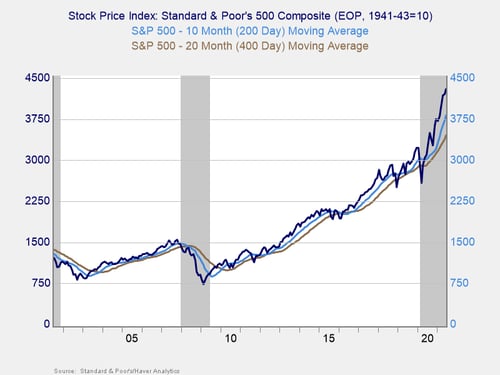
Technical factors remained supportive for equity markets throughout June. The S&P 500, which managed to break above its 200-day moving average at the end of last May, finished above trend for the 14th month in a row. This also marks 12 consecutive months with all three major indices finishing above trend.
The 200-day trend line is an important technical signal that is widely followed by market participants, as prolonged breaks above or below could indicate a longer-term shift in investor sentiment for an index. The 400-day trend line is also a reliable indicator of a change in trend. The continued technical support for markets in June was encouraging, so we have left this signal at a green light.
Signal: Green light
Risk factor #4: Market complacency. This is a recently added risk factor that aims to capture a standardized measure of market complacency across time. Complacency can be an uncertain term, so this chart identifies and combines two of the common ways to measure complacency: valuations and volatility.
For the valuation component of the index, we are using the forward-looking price-to-earnings ratio for the S&P 500 over the next 12 months. This gives an idea of how much investors are willing to pay for companies based on their anticipated earnings. Typically, when valuations are high, it signals that investors are confident and potentially complacent. For volatility, we have used the monthly average level for the VIX, a stock market volatility index. When volatility for the S&P 500 is high, the VIX rises, which would signal less complacency.
By combining the two metrics in the chart below, we see periods where high valuations and low volatility have caused peaks, such as 2000, 2006–2007, and 2017. We saw market drawdowns within roughly a year following each of these peaks.
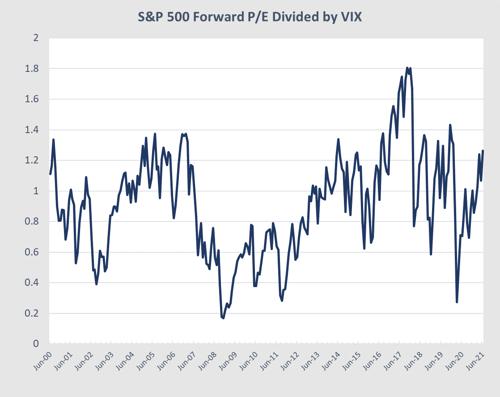
Looking at the current chart, market complacency has picked up compared with earlier in the year, and now sits at its highest level since the start of the pandemic. The average VIX reading for the month fell from 19.76 in May to 16.94 in June, which is the lowest average monthly VIX level since January 2020. The forward-looking P/E ratio for the S&P 500 increased slightly, rising from 21.1 to 21.4. The combination of falling volatility and higher valuations caused the index to increase from 1.07 in May to 1.26 in June, which is the highest level since the start of the pandemic.
Readings above 1.2 have historically been a signal that market complacency is at potentially concerning levels, so this increase back into the historical danger zone is worth monitoring. Given the fact that complacency appears to be increasing, we have downgraded this indicator to a yellow light.
Signal: Yellow light
Conclusion: Market Risks Declining but Still Present
Economic fundamentals showed further improvement in June, driven by advances on the public health front and continued nationwide reopening efforts. We saw high levels of consumer and business confidence during the month, which should help support continued spending growth in the months ahead. Given the improving economic fundamentals, we are approaching a potential upgrade for the overall economic and market risk indicators, but risks remain that should be monitored.
The pandemic still represents a risk for markets, and rising concerns over the Delta variant has led to some equity market volatility. While the medical risks have diminished notably compared with earlier in the year, they still have the potential to affect markets and should be monitored.
Ultimately, the path back to a more normal economic environment is likely going to be long, and we can expect setbacks along the way that could drive further volatility. With that said, it appears that the worst impact from the pandemic on markets and the economy is likely behind us. Given the improvements for many of the factors that we track in this piece compared with earlier in the year and the continued economic recovery during the month, we have left the overall market risk level at a yellow light—but we may see further market volatility in the months ahead.



 Print
Print

